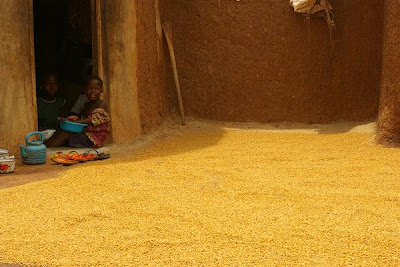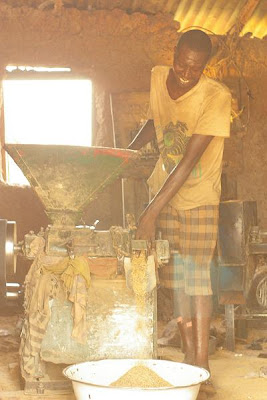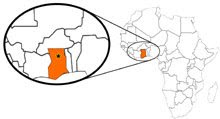Life here is good. My health was somewhat sub-optimal earlier in my placement, but I’ve been feeling surprisingly healthy for the last week or two. Last night I finished an entire bowl of rice, a feat I had accomplished only once previously. I also consumed a smaller bowl of rice in the morning, four bags of groundnuts (peanuts), five bananas, half a mini-loaf of bread and what was probably too much choco delight (made-in-Ghana chocolate spread). The ten kilometer bike ride helped.
I’m still eating a lot of rice and maize, but they’re starting to grow on me. My favourite local food is probably waakey (“wa-chay”), which is made from rice and beans. Adisa (my host mother) sells waakey to school children every morning and I almost always go and buy it from her.

I eat waakey (rice and beans) every morning. The noodles are a bit of an extra touch.
Teazed (maize flower) is typically what we eat for dinner, although the type of soup varies. Almost all feature peppers and dehydrated fish, but my favourite is okra mostly because it includes the ever elusive green vegetables. Dinner can also take the form of rice balls (basically teazed but with giant balls of rice instead of maize) or jollof rice, which is rice cooked in a pepper sauce. The other night we had jollof watchay, which was a spectacular surprise.

Teazed is made from maize flower. The type of soup can vary; some have a tomato base while others are made from groundnuts.
On the weekends I tend to succumb to my love of eggs and fry up four or five for lunch. The concept of fried eggs isn’t foreign in Tolon, but from what I’ve seen it’s only the men who really eat them and don’t seem to do so often.

Frying eggs on a charcoal cook stove.
A couple weeks ago Tolon had a surprise visit from the American military. Naturally I was a little surprised to find marines parked outside the front of our compound, so I decided (along with half of Tolon) to go and investigate. The Americans went to greet the town elders (the chief was in Accra) and most people followed to watch. Unfortunately spectation isn’t really an option for a tall white man in Tolon and I ended up sitting in the front with all the soldiers as they talked with the elders and explained their mission. At first I thought they were part of the training operation the Americans are doing in Ghana, but they said they were actually veterinarians doing a routine service operation. Apparently they fly all over the world and go around de-worming goats and cows. They also have a human health unit. I’m still a little skeptical that their presence doesn’t have anything to do with the training operation, but they did go around treating animals the following day. I also can’t imagine how flying American military vets to various regions of the world is a cost effective development strategy. Perhaps it has less to do with poverty reduction and more to do with improving the global image of American forces abroad.

American forces outside my home in Tolon.
As there aren’t always American soldiers in town, I have to find other ways to occupy my time. Since on of my goals of being in Ghana is to learn as much about Ghanaian life as possible, I devised a list of things I want to do before I leave. When I have some extra time I browse the list and pick an adventure to tackle. One Sunday I decided I was going to go pray at the nearby mosque.

The nearby mosque. One of five or six in Tolon.
Muslims (at least the ones in Tolon) pray five times a day. The first prayer is at 5:30am, then again at 1pm, 3pm, 6:30pm and 7:10pm. Each time one of the old men will go inside the mosque about fifteen minutes beforehand and start broadcasting his prayers through the megaphone on the roof of the mosque. While some volunteers have expressed irritation at waking up to this, I don’t mind it so much. Participating in the morning prayer was actually my favourite; the air was still and the sun had not yet risen. The actions of bowing on the knees and chanting give it an almost meditative feel. I also learned how to do abolishment, which involves using water to wash the hands, head and feet before entering the mosque.
I was a little concerned about my presence being disrespectful, but my friend Mohammed reassured me that it was okay for me to participate. After the first prayer was over the old men smiled at me and were eager to shake my hand, making me feel welcome. It wasn’t until the evening that I realized people had assumed I was planning to come every day to pray. Even now people will still jokingly ask me to come to pray with them. In retrospect I probably should have been a lot clearer on my intentions. I’m not entirely sure if I’ve offended anyone and don’t know if I would go back and do it again, but I’m still very grateful for the experience. I would probably never have even seen the inside of the mosque otherwise.
Life with my family has also evolved. Ayisha and I will joke around a lot and I feel like a strong friendship is developing. Sometimes she’ll help and/or laugh at me wash clothes, other times I’ll help her read or carry water. Mostly I think she finds me amusing and I enjoy the way her face lights up when she first sees me. Sala, who is called Ma Sala or “Mother Sala” because there are too many Salas, is as happy as ever. It’s pretty hard not to find her chubby waddling little walk cute. Sometimes I try to get her to talk to me by asking her simple questions in Dagbani like “where are you going?”, “what are you doing?” or “where are you eating?”, but she usually only talks to her direct family. Baba doesn’t speak much English, but I’ve noticed our relationship change. We still don’t have a lot of interaction, but he’s started to find me less intimidating and more amusing. He and some of the other children have started calling me “Brother Sam” which I think is a further indication that they consider me more approachable. My host mother, Adisa, loves to talk loudly in a big stern voice, but is really quite loving and often jokes around with her children. When I walk through town people usually greet me in my Dagbani name, “Wumpini” and ask how I am or where I’m going. In many ways I feel like the town mascot. People find me amusing, but I also feel like there’s a growing level of respect. I feel welcome.

Ayisha, 13 years old.

Ma Sala ("Mother Sala"), 3 years old.

Baba, 9 years old.
In coming to Ghana, one of my greatest fears was that I wouldn’t be able to connect with people. I’ve always been a bit of an introvert and had seen this as a weakness in terms of integrating into a new culture and building relationships. My experience has been quite the opposite. Whatever insecurities I have about my placement from a work point of view, I feel good about the successes I’ve had at making friends and becoming a part of life in Tolon. Last night Adisa told Ayisha to ask me how long it’s been since I came to Tolon and how long I’m going to stay. When I told them two more months they were a little bit upset. They asked who will make them laugh in the evenings once I’ve gone. Before I leave, they said, I have to be sure I take a picture with them and Baba and Ma Sala and get it printed.
I was telling Sarah about this experience and she asked me what I think I’ve done to be so successful at building these relationships. Honestly, I think a lot of it is just having the good fortune of finding an awesome family in an awesome town. When I came to Tolon I had hoped to get to know people, make a few friends and be able to say I didn't screw it up too badly. I never expected to have people miss me; I never expected to leave feeling loved.

Playing owaray (African stones game).

Ayisha (front, in black) and some of the other kids who live near my home.















